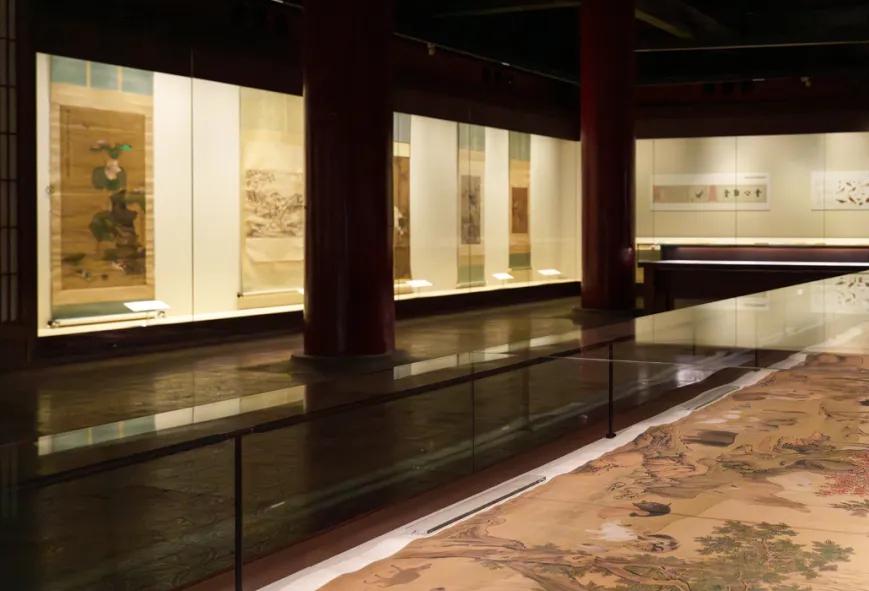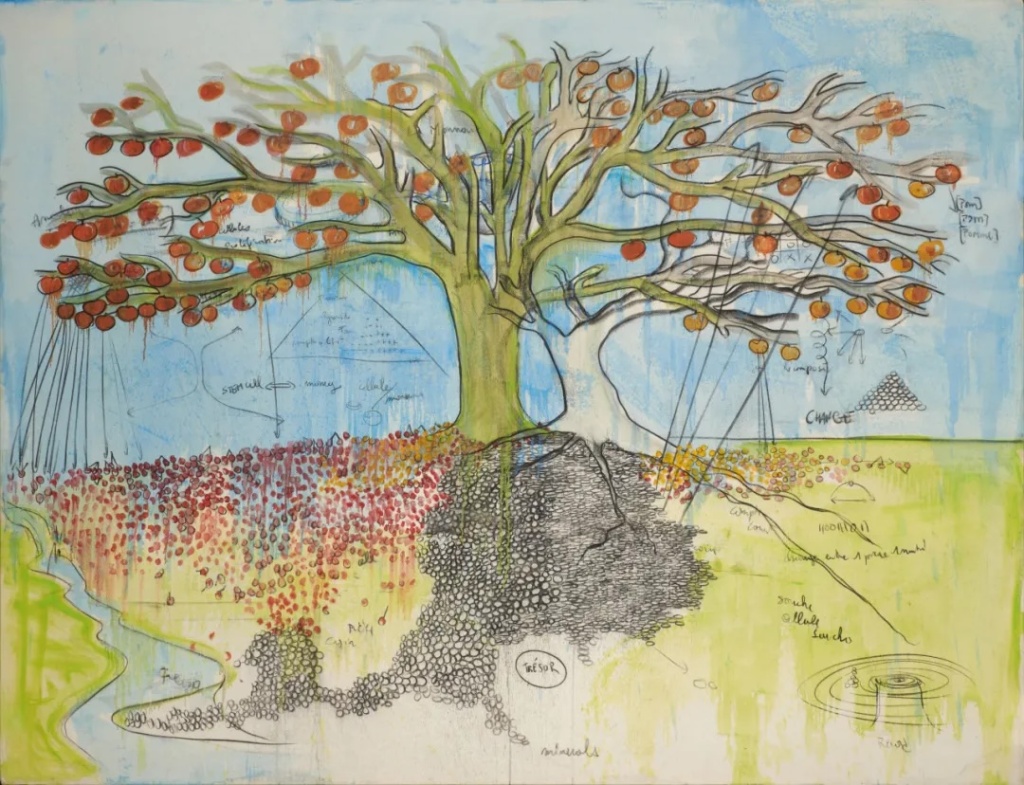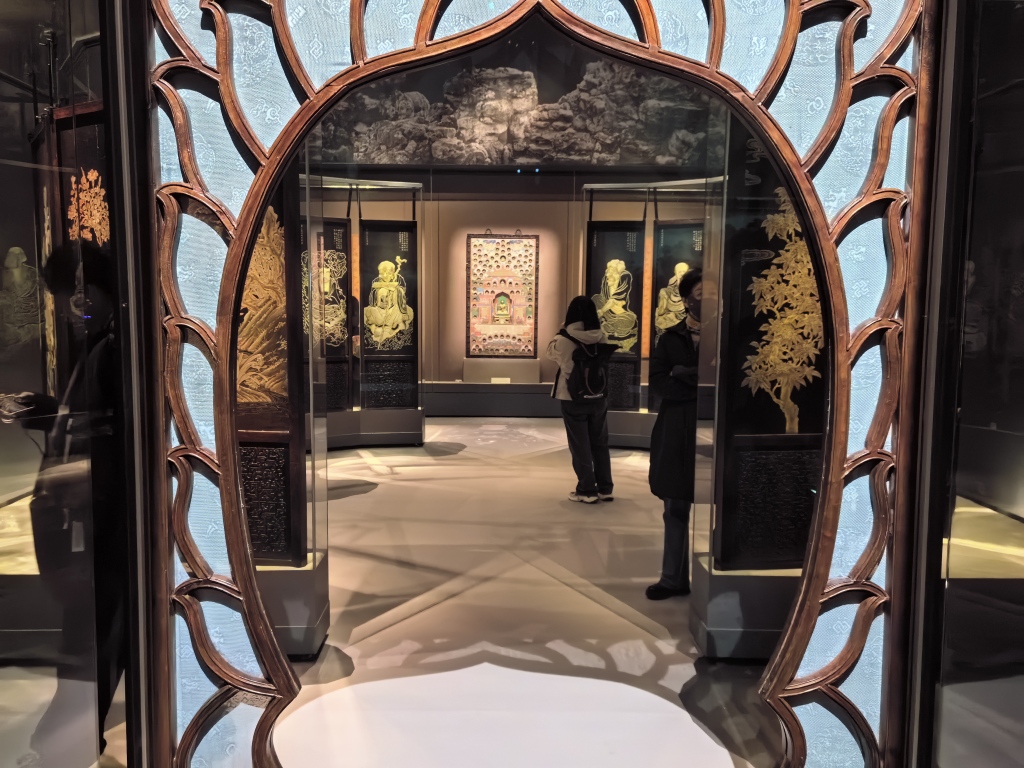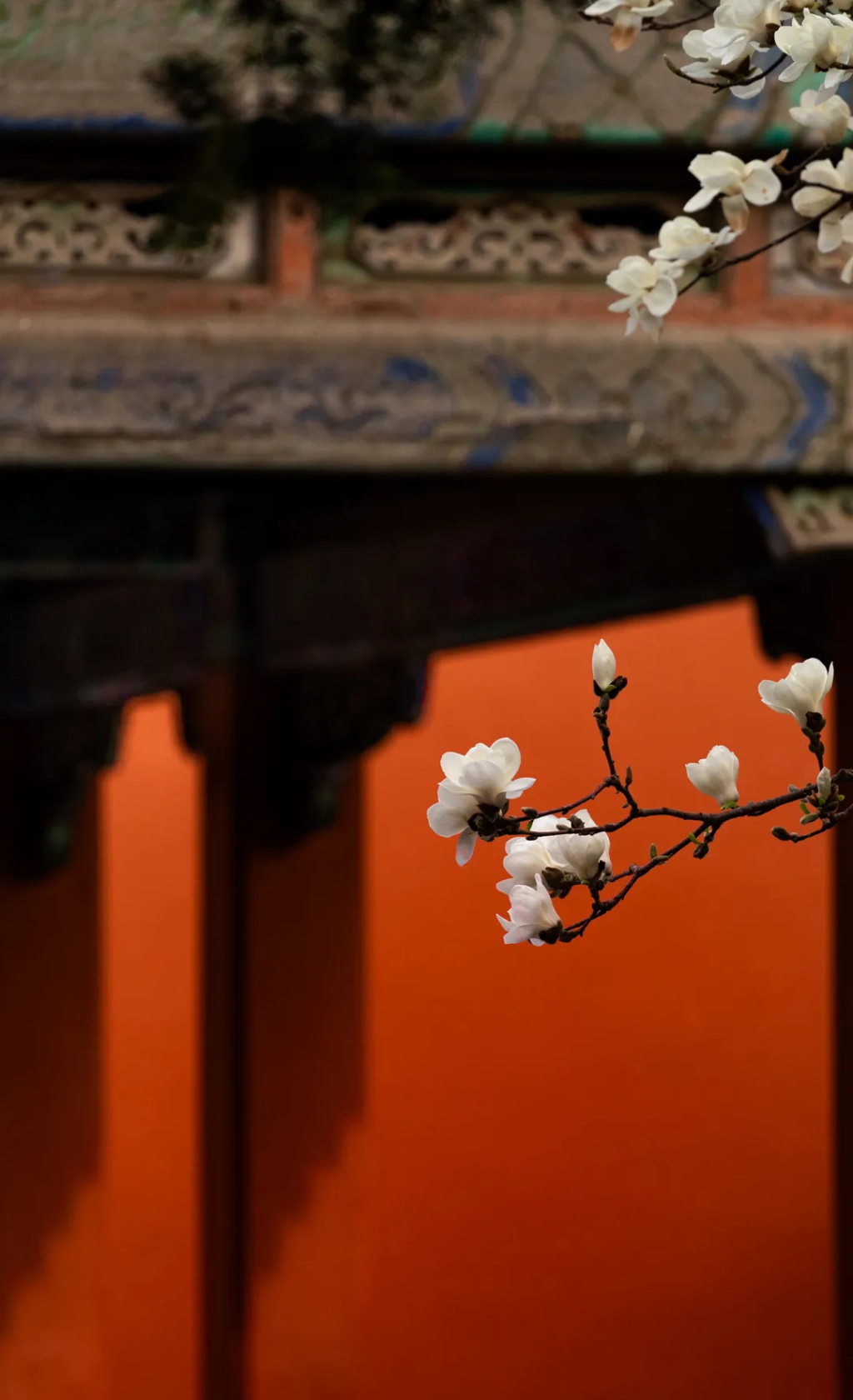
During the Qingming Festival, spring is in the air. What kind of grand scene will it be when the legendary Xiyuan Elegant Gatherings took place - the private garden of Northern Song Dynasty scholar Wang Shen, the Qianlong Garden in the Forbidden City, the Ming Dynasty Suzhou Dinghui Temple Zen Temple, the Italian Pompeii Villa Garden, the medieval monastery garden, the French Versailles Palace Garden, the Japanese Edo Period Garden, Monet's Garden... famous gardens from China and abroad gather together? Please see the "Le Lin Quan - Chinese and Foreign Garden Culture Exhibition" jointly sponsored by the Palace Museum and the Art Institute of Chicago.

The Palace Museum
Lelinquan: A poetic reconstruction of the relationship between man and nature
Gardens are man-made landscapes that are based on natural elements (mountains, water, plants) and artificial structures (buildings, roads, sculptures). Through artistic layout and space design, they achieve multiple functions such as viewing, rest, and cultural expression. The essence of a garden is a poetic reconstruction of the relationship between man and nature, which not only embodies technicality, but also carries philosophical and aesthetic connotations.
This exhibition focuses on gardens, with "Garden Elegance" as the narrative focus. It is based on Chinese classical garden art, but also looks at global garden culture. Through the six major garden events of elegant gatherings, collections, mountain tours, meditation, flower viewing, and music, it unfolds a dialogue on garden art that transcends time and space.
The name of the exhibition, “Enjoy the Forest and Springs”, is taken from the poem written by Emperor Qianlong himself on the scroll of the exhibit “Gao Tu Jing She Tu”. “Lin Quan” is the poetic expression of natural landscapes by ancient Chinese people, and “enjoy” the “lin Quan” is the pursuit of living in the garden.
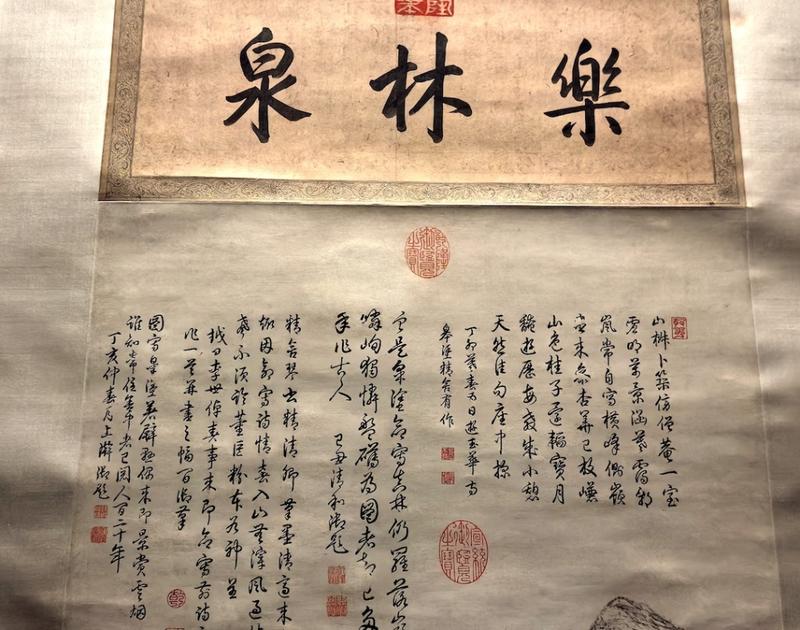
Part of the "Gaotu Jingshe Picture"

Part of the "Gaotu Jingshe Picture"
This exhibition displays more than 200 pieces/sets of Chinese and foreign exhibits, which are distributed in the Meridian Gate and the East and West Wing Exhibition Halls of the Palace Museum. Before entering the specific exhibits, the first thing to pay attention to in this exhibition is its unique immersive exhibition layout.
According to Sun Miao, deputy director of the Exhibition Department of the Palace Museum, the six exhibition units are distributed in three exhibition halls. Each exhibition hall extracts the exhibition colors according to the exhibits. The three exhibition halls focus on the themes of mountains, water and flowers respectively.
For example, the theme of the West Wing Exhibition Hall is "Water", which comes from the tradition of literati gatherings, such as the winding water flowing wine cups. Standing at the entrance of the West Wing Building, you can see the display cabinets winding like water from a round flower window. Visitors stop by the display cabinets, just like the literati and scholars wandering by the waterside during the West Garden Gathering. "Our display cabinets simulate the feeling of the sparkling water surface. The back panels are matched with yellow and green. The pillars in the exhibition hall are decorated with bamboo knot patterns. Chinese and Western cultural relics are interspersed in the exhibition hall, giving the audience a sense of mutual contrast."

Exhibition View
The West Wing Building presents two exhibition units: elegant gatherings and collections.
In the mountains and forests, by the winding waterside, the Lanting Gathering, which took place more than 1,600 years ago, has left an everlasting ripple in the hearts of Chinese literati. The place for drinking and reciting poems is integrated into the garden, and elegant and famous poems are everywhere.

The elegant gathering of wine drinking on the winding stream in the Ming Dynasty's "Relaxation Scroll"
Lush forests, tall bamboos, clear streams, and turbulent rapids are the eternal poetry of the classical world. A scroll of "Ink Bamboo (One of the Gentleman's Forests by Yuan Dynasty)" was painted by Li Xun of the Yuan Dynasty. The room on the west side of Jianfu Palace is named "Sanyou Pavilion", which means "Three Friends of Winter". Emperor Qianlong stored Cao Zhibai's "Eighteen Gentlemen" (biography), "Plum Blossoms by Song and Yuan Dynasty" and "Gentleman's Forest Scroll by Yuan Dynasty" in this room. "Sanyou Pavilion" is decorated with pine, bamboo and plum patterns, and these plants are planted outdoors to correspond to the content of the three scrolls. Li Xun's bamboo painting imitates nature. In the picture, the ink bamboo stands upright, shaped like a phoenix tail.

Part of the Ink Bamboo Scroll (One of the Gentleman's Forests by Yuan Dynasty)

Detail of "Eighteen Gentlemen" by Cao Zhibai (attributed)
While people are recalling the poems and essays left by the noble scholars in the Lanting, Xiyuan, Yushan and other elegant collections, the poems of Persian poets such as Saadi and Hafez also echo on the westward journey of the Silk Road. In the gardens that symbolize heaven, they discuss love, nature and life through fine wine, flowers and birds, mountains and rivers and quiet nights. Scholars from different civilizations and different times gather here, and the gardens become a place for the breeding of beauty and philosophy. The elegance in civilization has been sustainable since then.
The "Records of Famous Paintings of All Ages" in the Tang Dynasty mentioned "appreciation" and "collection". In ancient China, scholars appreciated and appreciated ancient works in elegant gatherings, and also stored and read ancient works in their study rooms. In the Ming Dynasty, scholars were very interested in planning their own small garden study rooms in winding streams and mountains, where they could interact with ancient objects and ancient people in the quiet gardens.
Qianlong built a special room in Jingyi Pavilion in the Jianfu Palace Garden to collect four famous works: Gu Kaizhi's Admonitions to Court Ladies, Li Gonglin's Lying Tour of Xiaoxiang, General View of Shuchuan, and Nine Songs. He named it "Four Beauties" after Wang Bo's "Preface to the Pavilion of Prince Teng", which says "four beauties and two difficulties". This exhibition restores its furnishings based on the records in archives and books.

The "Four Beauties" spatial restoration scene in the exhibition hall
In Italy during the Renaissance, a large number of unearthed ancient sculptures and other artworks were collected by popes, nobles and wealthy businessmen to decorate their homes and gardens, demonstrating their power and wealth. In the 18th century, exotic customs from the East swept across England, and designers constructed imaginary Chinese pavilions, corridors, pagodas and other buildings, which were like "flying peaks" and became the finishing touch of fashion in natural landscape gardens.

Colonnades and gardens of the Medici Palace after 1870
Chinese and Western civilizations meet in the painting. Kew Gardens was originally a 3.5-hectare botanical garden in the estate of Princess Augusta. It has now expanded to the 120-hectare Royal Botanic Gardens of the United Kingdom. There are a large number of exotic architectural pieces in the garden. Among them, the Chinese pagoda is said to be built with reference to the glazed pagoda of Nanjing Da Baoen Temple, adding an elegant and picturesque artistic conception to the place. After its completion, the pagoda became the inspiration theme of many works of art.

The Tower and Bridge in Kew Gardens, 1762 Richard Wilson (UK)
Traveling in the mountains, looking for a quiet place that transcends the mundane world
The theme of the Forbidden City's Meridian Gate Exhibition Hall is "Mountain".
Most of the classical Chinese gardens have "mountains". The imagery of fairy mountains and caves, and the pursuit of being close to forests and springs even though living in the city, are all pinned on mountains. Mountains and waters can "home the heart", "nourish the heart", and "cultivate the mind". If you erect a rockery made of lake stones, you can seem to see the clouds and mist in the sky; if you place a pavilion, you can attract the bright moon and fresh breeze. The ancient Chinese people wandered in the rockery in the garden, or wandered in the real mountains and real waters, all in pursuit of a spiritual space that transcends the mundane world.
It is worth mentioning that the Qianlong Garden, which will be open this year, is also cleverly embedded in the exhibition. At the beginning of each exhibition hall, there is a stamp of the Qianlong Garden, symbolizing that this exhibition starts from the Forbidden City to see the world.

The Qianlong Garden, which will open this year, is also cleverly embedded in the exhibition.
The colors used for the Meridian Gate Exhibition Hall are the colors of rocks - gray, white, and some gold.
The exhibition units covered by the Wumen Exhibition Hall are "Mountain Tour" and "Quiet Cultivation". Most of the classical Chinese gardens have "mountains". The image of immortal mountains and caves, the pursuit of forests and springs within reach of the city, are all pinned on mountains. Mountains and waters can "home the heart", "nourish the heart", and "cultivate the mind". The ancient Chinese people traveled in the artificial mountains in the garden, or in the real mountains and waters, all in pursuit of a spiritual space that transcends the secular world.
The shapes of the rockery in the Qianlong Garden and different gardens of the Forbidden City are dotted in the exhibition hall in the form of images or videos.

Exhibition site
A piece of Lingbi stone located in the southwest corner of Suichu Hall was moved to the exhibition hall and placed on a white marble base. On both sides, there are lotus-shaped stone bases with copper bottles on them. From a distance, the stone peak looks like a fairy mountain, with clouds below and a cave in the middle. From a close look, there are gullies and obvious lines, which are quite interesting.

Lingbi Stone at the exhibition
The most noteworthy exhibit in this section is the "Auspicious Dragon Stone Scroll". This scroll is recognized as the authentic work of Emperor Huizong of Song. The picture depicts a Taihu stone with the two characters "Auspicious Dragon" written in regular script on the stone. This stone stands to the south of Huanbi Pond and to the west of Fangzhou Bridge, and is the key point of the garden scenery. Huanbi Pond is close to Xuanhe Hall, and both belong to the back garden area in the northwest corner of the palace. Xuanhe Hall is an important place for the collection of calligraphy and painting, books and bronze and stone inscriptions.

Auspicious Dragon Stone Scroll
The scroll of "Yousong Tujuan" by Du Qiong of the Ming Dynasty was created for his sister-in-law Wei Yousong. The scroll depicts a conversation between scholars in a garden, two people unfolding scrolls and appreciating them on a couch in the room, and outside the house, there are winding pines, and at the end of the scroll, there are several rockery peaks, which are staggered and well-organized, with a dense but not blocked structure. The author's brushwork is delicate and elegant, and his style is a fusion of Wang Meng and Wu Zhen.

Ming Dynasty Du Qiong "Friends of Pine"

Ming Dynasty Du Qiong "Friends of Pine"
The scroll of "Wansong Jinque" by Zhao Boqi of the Song Dynasty has no signature or seal. There is a postscript by Zhao Mengfu of the Yuan Dynasty on the back of the scroll, which claims that it is the authentic work of Zhao Boqi. The scroll depicts the scenery of Wansongling in Fenghuang Mountain in Lin'an (now Hangzhou). Wansongling is beside the West Lake, and there are many royal palaces on it. At the beginning of the picture, the water surface is open, the pine forest on the hillside is lush, and the golden-roofed palace is looming. The brushwork is sophisticated but clumsy, forming a new style of green landscape with elegance and grace.

Zhao Bosu, Song Dynasty, "Ten Thousand Pines and Golden Palaces"
Qian Weicheng's "Royal Garden Ancient Cypress Scroll" from the Qing Dynasty shows the northeast corner of the Forbidden City's Imperial Garden. On the left is Duixiu Mountain, with the Imperial View Pavilion on top. Duixiu Mountain was first built in the Ming Dynasty and was originally named Duixiu Mountain. It was the place where the emperor, empress and concubines climbed on the Double Ninth Festival. There is a cave in front of Duixiu Mountain, with a brick-built dome-style stone-carved Panlong caisson. On both sides of the stone cave door are stone Panlong fountains, which can spray water from the Panlong's mouth. It is the only water fountain in the palace. These buildings are all intact.

Qian Weicheng, Qing Dynasty, "Ancient Cypresses in the Imperial Garden"

Qian Weicheng, Qing Dynasty, "Ancient Cypresses in the Imperial Garden"
In Islamic and European formal gardens, nature is idealized as a perfect geometric structure. During the Renaissance, Italian terraced gardens were built in layers on the mountains, and visiting terraced gardens became a kind of mountain tour. Artificial caves that imitated mountain caves and unique giant statues that metaphorically represented the gods of nature made gardens a product of art entering nature. The wave of the Renaissance allowed people of the time to rediscover the glory of humanity in their tours between nature and divinity.

Villa d'Este, from the collection of Roman beauties
The changing natural landscapes of the four seasons in Chinese classical gardens, the imagery of the world in a pot, and the metaphor of entering the world and leaving the world are all perfect objects of meditation for practicing tranquility and cultivating the mind. In the Buddhist building surrounded by rockery in the imperial garden, Emperor Qianlong once burned incense and worshipped Buddha; in the temple gardens surrounded by mountains and rivers, the practice of cultivating the land by day and meditating at night has continued for thousands of years. In medieval monasteries in Europe, monks prayed and meditated in the cloisters, planted herbs and flowers in the central courtyard divided by a cross, and comforted their souls with gardening work with their hands.
The meditation exhibition unit creates a place for meditation with the Sixteen Arhats screen from Yunguang Tower.

The Quiet Retreat exhibition unit uses the Sixteen Arhats screen in Yunguang Tower to create a quiet retreat place
Viewing flowers and enjoying music: A look into the daily life of scholars living in gardens
Watching flowers, painting flowers, and chanting about flowers are the daily routines of literati living in gardens. "Don't let people praise the beauty of the color, just leave the clear air to fill the universe", the fragrance of plum blossoms fills the universe because of Wang Mian's awe-inspiring and noble character; "Helplessly the flowers fall, the familiar swallows return. I wander alone in the fragrant path of the small garden." Yan Shu looked at the fallen flowers in the garden with melancholy, recalling the past... Chinese literati endowed flowers with the pursuit of character, poured their understanding of life into the garden, and also wrote these images in poems and painted them on scrolls, leaving them for us to see today.
The theme of this exhibition unit is "flowers". When you enter the exhibition hall, you can see the curtains of wisteria swaying in the wind, and the ground is also covered with wisteria petals.

Flower Theme Exhibition Hall

Flower Theme Exhibition Hall
Monet's three works are distributed at the beginning and center of the exhibition hall.

Claude Monet Water Lilies (detail) Art Institute of Chicago

Claude Monet, Water Lily Pond (detail)

Claude Monet Self-Portrait
The scroll painting "Hongli Viewing Lotus and Playing the Qin" depicts Emperor Qianlong playing the qin in a pavilion by the water, with lotus flowers in the water and mountains and flowing water in the distance, implying the lofty and detached state of mind of the characters in the painting. Like many court paintings of the same period, this painting was completed by a Western painter for the portrait part, and then the landscape background was added by a Chinese painter. The painting style is harmonious, reflecting the elegant and rich aesthetic taste of court paintings.

"Hongli Viewing Lotus and Playing the Zither"
Gardens can be listened to. In Chinese gardens, there are natural symphonies of rain hitting banana leaves and wind blowing through bamboo forests, as well as the sound of zithers and harps in pavilions and terraces that harmonize with the sound of wind and water. The music created by people in gardens blends with the sounds of nature and interweaves with the landscape of the gardens, as if it can bring the people who appreciate the music into another time and space of the gardens.
During the Ming and Qing dynasties, gardens and operas were connected. The unattainable dreams in Romance of the West Chamber and Peony Pavilion were placed in gardens and performed in gardens. At the grand garden party held by Louis XIV at the Palace of Versailles, the performance of Trickster was a powerful and inspiring voice in the history of drama. Today, more and more music and dramas from distant times are returning to gardens to enter contemporary life. The music they sing is still melodious and ever-new.

Changyin Exhibition Unit

Changyin Exhibition Unit
The "Autumn Wild Goose Album" is a work from the Ming Dynasty. The album of the ancient guqin music "Autumn Wild Goose" handed down by the Xu School of the Zhejiang School, which was formerly in the Ming Palace, has pictures first and then scores. The accompanying pictures are drawn according to the artistic conception of the score, showing the activities of wild geese on the riverside, sandbanks, and reeds in autumn. The author uses horizontal composition to show the close-up scenes such as the sandbank by the water, the slopes and the shores. Although the painting is small, it is fascinating.

Autumn Wild Goose Atlas
The small stage of Juanqinzhai is located at the western end of the indoor Juanqinzhai at the northernmost end of Qianlong Garden. In this exhibition hall, the small stage was reconstructed with modern design techniques, and the indoor images of Juanqinzhai were reproduced using a mirror screen, combining the virtual and the real to create a spatial experience of being in Juanqinzhai for the audience.

Juanqinzhai small stage
